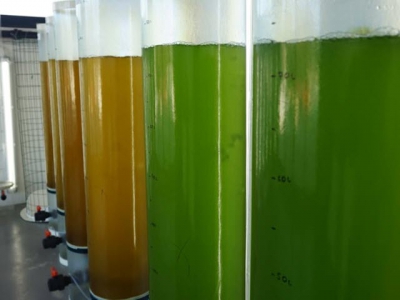Shrimp thrive on microalgae feeds

Substituting microalgae for at least part of the fish oil content contained in shrimp feeds can improve the growth rates and FCRs of whiteleg shrimp.
Microalgae-based products are gaining credibility as alternatives to fish oil in the diets of many species of finfish and shrimp Photo © Algared
So concluded a team of Brazilian researchers after setting up a study to evaluate the use of algal meal made from Aurantiochytrium species as a substitute for fish oil in the diet of juvenile Pacific white shrimp (Litopenaeus vannamei) reared in a clear‐water system.
The researchers trialled diets in which levels microalgal meal used as a replacement for fish oil varied from 0 percent to 100 percent. After 46 days they established that replacing 44.7 percent of the fish oil for microalgae meal was optimal for growth rates, while the feed conversion ratio (FCR) of animals fed a diet of Aurantiochytrium sp. meal decreased at inclusion rates of up to 50 percent, with an optimal percentage of replacement estimated at 49.3 percent.
The microalgae diets also increased the levels of the long chain polyunsaturated fatty acid docosahexaenoic acid (DHA) in shrimp muscle tissue from 10.03 percent to 14.28 percent.
As a result, the researchers concluded: “The partial replacement of fish oil by microalgae meal resulted in improved shrimp growth and FCR, and total replacement of dietary fish oil had no negative effects on these parameters. In addition, inclusion of microalgae meal raises the level of DHA in shrimp muscle.”
Có thể bạn quan tâm
 Seafood exports to China set US$1.5 billion target for 2019
Seafood exports to China set US$1.5 billion target for 2019 China is one of four markets where Vietnamese seafood products hit more than US$1 billion per year in import value and is considered one of the most important
 Vietnam’s tuna exports show no good sign after effective date of VJEPA
Vietnam’s tuna exports show no good sign after effective date of VJEPA Within ten years since the effective date, Japan, as committed, will reduce its tax imposed on 94% of Vietnam’s products imported into this country
 Vietnam’s pangasius conquered many major Chinese cities
Vietnam’s pangasius conquered many major Chinese cities Through online channels such as China's leading e-commerce platform Alibaba, Vietnam’s pangasius products have been exported to many major Chinese cities.